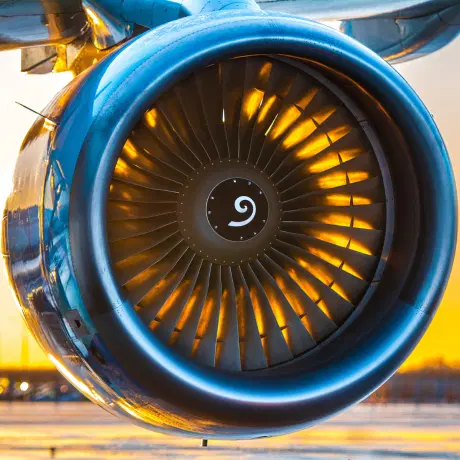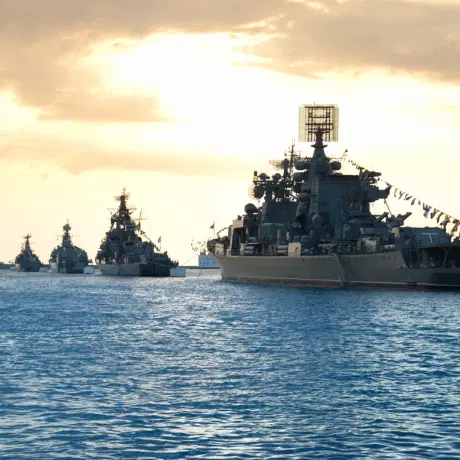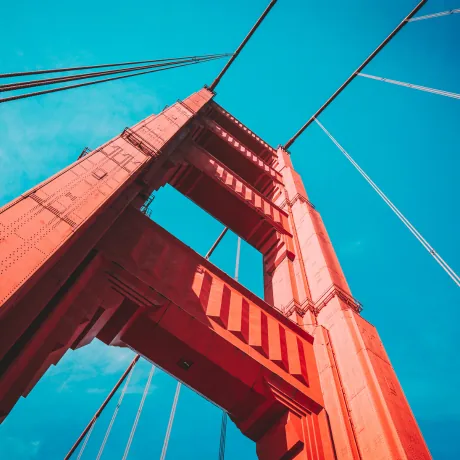Steel 300M - A646 - K44220
300M steel (developed in the 1950s by U.S International Nickel Co.) is a low-alloy, ultra-high-strength steel. Originally derived from 4340 steel for aerospace applications, the goal was to increase mechanical strength while maintaining excellent toughness. In practice, it is an AISI 4340 modified by adding silicon and vanadium, with slightly higher carbon and molybdenum content. It is also produced by vacuum arc remelting (VAR) to ensure purity and homogeneity.
Available shapes :
Order 300M Online
Select the desired form, standard, or specification and place your order with one click. A member of our sales team will contact you promptly to finalize your order.
300M, the result of optimizing the chemical composition of 4340
The designation “300M” is a commercial name that has become widespread. It is also referred to as AISI 4340M (modified 4340), sometimes written AISI E4340 Mod. Its UNS (Unified Numbering System) designation is K44220. It has no direct counterpart in the French/European standard but would correspond to a modified 40NiCrMo7 steel.
As seen earlier, 300M differs from conventional 4340 steel through its higher silicon content (~1.6 % vs ~0.25 % for a 4340) and the addition of a small fraction of vanadium (~0.05–0.1 %). Its carbon and molybdenum contents are also slightly higher than its predecessor.
This composition is optimized for superior hardenability and core strength. Silicon at this level delays the tempering of martensite. By inhibiting the precipitation of cementite carbides (Fe3C) during tempering around 572 °F, it preserves very high strength, as illustrated by this diagram: [see schematic below, fig. 1]
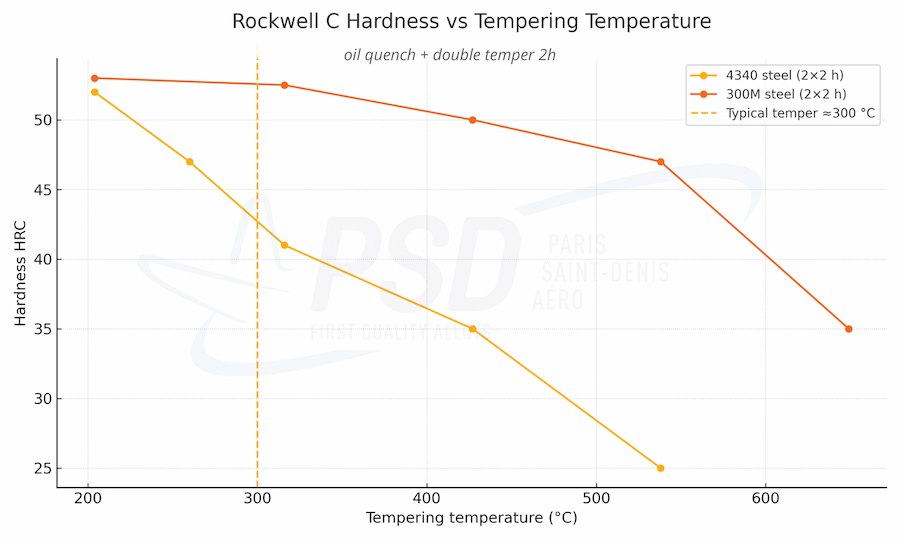
- Up to ~572 °F, the hardness of both grades remains very high; 300M keeps a slight advantage (~1 HRC).
- Between 572 °F and 806 °F, 4340 starts to soften markedly (about 8 HRC loss), whereas 300M drops much more slowly (-3 HRC).
- Beyond 932 °F, the gap widens: 300M still retains ~47 HRC whereas 4340 falls to ~27 HRC.
Finally, the very small addition of vanadium refines the grain size during heat treatment (formation of V carbides/nitrides), improving both strength and toughness.
Mechanical properties of 300M, specialized in fatigue resistance
Like most ultra-high-strength steels, 300M shows no fatigue plateau indicating an absolute fatigue limit: the stress-versus-cycle curve continues to decrease beyond 10⁶ cycles.
In a more ductile steel such as 17-4 PH (condition H1025), local micro-plasticity blunts the tip of an emerging crack; the stress is redistributed and crack propagation arrests, giving rise to a fatigue limit. Nothing of the sort occurs in 300M, which is low-ductility and also has a low propagation threshold, so a micro-crack advances as soon as it experiences repeated loading.
Nevertheless, 300M was specifically designed to improve fatigue life over 4340 steel. It therefore provides excellent fatigue endurance, higher than that of 4340 under comparable conditions. Its cleanliness (thanks to vacuum melting) coupled with its fine tempered martensite give it good toughness, which slows crack growth and shifts the entire fatigue curve upward. Propagation thus remains slower than that of 4340 owing to its toughness and cleanliness.
Finally, like all high-strength steels, it exhibits limited work-hardening, and its elongation at break (7–8 %), although modest, is noteworthy given its high strength level.
Heat treatments of 300M, a through-hardened alloy
300M is a through-hardening alloy, with core hardness close to surface hardness. It requires meticulous heat treatment to develop its optimal properties; the slightest deviation can drastically reduce its performance.
Normalising and quenching
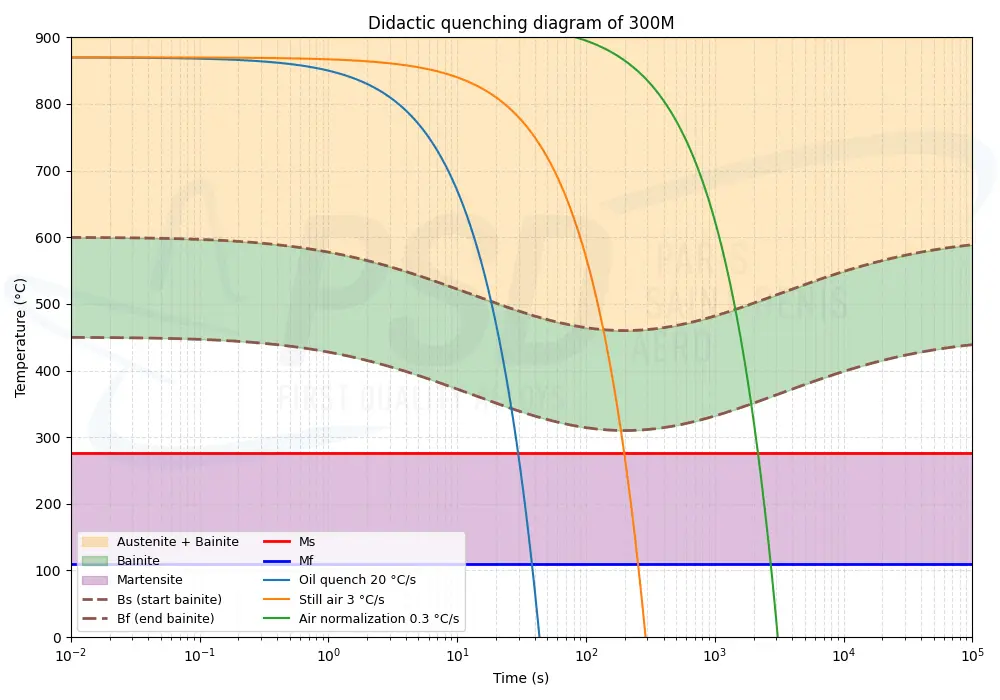
The green curve in the diagram above (fig.2) represents air cooling carried out at 1697 °F for 1 h after normalising. It homogenises the microstructure (uniforms the internal composition); the grain is refined and becomes more regular. The metal emerges with a fine microstructure, usually bainitic, ready for hardening. This heat treatment is used after hot forming or manufacturing 300M.
The orange and yellow curves (fig.2) represent two cooling methods after austenitising (1598 °F for 30 min to 1 h): respectively forced-air cooling (≈ 5.4 °F/s) and oil quenching (36 °F/s). This treatment heats 300M just enough to dissolve carbides, allowing alloying elements and carbon to enter solid solution in the new austenite structure. Because the high Si content increases the opposite tendency to decarburisation, it is carried out in a controlled or vacuum atmosphere to avoid it. Quenching is preferably performed in oil, immediately on leaving the furnace, to obtain martensite throughout the section. 300M shows excellent hardenability: even thick sections (~90 mm) can be through-hardened, achieving hardness above 50 HRC.
Double tempering
After quenching, double tempering is mandatory to relieve internal stresses, complete transformation of any retained austenite, and stabilise the result. A lower temper will yield slightly higher strength at the expense of toughness, while a higher one will reduce strength (and hardness) while increasing toughness (see fig.3 below). Precautions are necessary, however: 300M exhibits temper embrittlement between 662 and 1022 °F if the soak lasts too long or cooling is too slow. In aeronautics it is generally performed at 572 °F for 2+2 hours, giving a strength of about 1900 MPa with toughness satisfactory for critical parts such as landing gear.
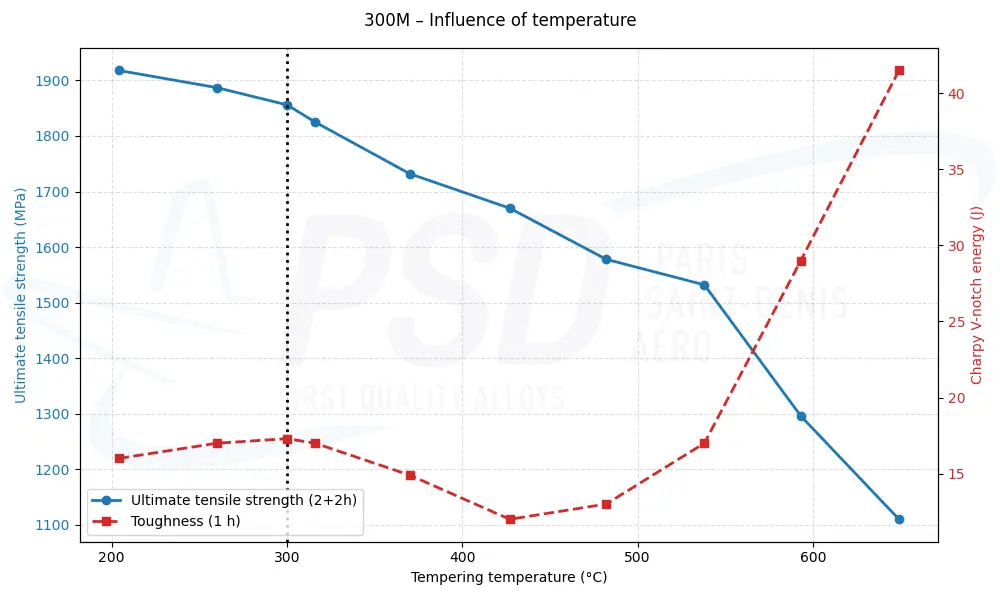
Machining and welding
Machining must be carried out in the soft state (annealed or normalised). Welding is delicate because the alloy hardens readily in air, increasing the risk of cracking. It can be welded, by resistance or fusion, only with strict precautions (preheat, post-heat) and a subsequent heat treatment (re-normalising + temper) after welding.
In short, 300M steel is a benchmark material when excellent mechanical strength, good damage tolerance (cracks, impacts) and long service life are required. Its flagship historical applications are aircraft landing gear for both military and civilian aircraft, where it long remained the standard.
Chemical composition of 300M
The variations in its chemical composition for aerospace.
| % | C Carbon | Cr Chromium | Cu Copper | Mn Manganese | Mo Molybdenum | Ni Nickel | P Phosphorus | S Sulfur | Si Silicon | V Vanadium |
|---|---|---|---|---|---|---|---|---|---|---|
| Min. | 0.40 | 0.70 | <0.00 | 0.65 | 0.35 | 1.65 | <0.00 | <0.00 | 1.45 | 0.05 |
| Max. | 0.45 | 0.95 | 0.35 | 0.90 | 0.50 | 2.00 | 0.010 | 0.010 | 1.80 | 0.10 |
Related steel alloys
12NC12, FE-PL61
ROUND BAR
15CDV6, 15CrMoV6, 1.7734, 1.7736, AIR 9160
SQUARE BAR, RECTANGULAR BAR, ROUND BAR, WIRE, SHEET, ROUND TUBE
16NCD13, 1.6657, 14NiCrMo 13-4
ROUND BAR
25CD4S, 1.7218, 25CrMo4, FLE-PL1502
RECTANGULAR BAR, ROUND BAR, SHEET, SQUARE TUBE, ROUND TUBE
30CD12, 1.8515, 30CrMo12, 31CrMo12, FE-PL1501
ROUND BAR
30CND8, 1.6580, 30CrNiMo8
ROUND BAR
30NCD16, 1.6747, 30NiCrMo16-6, FE-PL2107, 30Ni4CrMoA
SQUARE BAR, RECTANGULAR BAR, ROUND BAR
32CDV13, 1.8522, 33CrMoV12, FE-PL1504
ROUND BAR
35CD4, 1.7220, 34CrMo4, 35CrMo4, FE-PL1503
ROUND BAR, ROUND TUBE
35NC6, 1.5815, 35NiCr6, FE-PL2102
SQUARE BAR, HEXAGONAL BAR, RECTANGULAR BAR, ROUND BAR, WIRE
35NCD16, 1.6773, 36NiCrMo16, FE-PL2108
SQUARE BAR, RECTANGULAR BAR, ROUND BAR
40CAD6-10
ROUND BAR
40CDV12, 40CrMoV12, FE-PL1507
PROFILE
40NCD7, 40NiCrMo7
ROUND BAR
42CD4
ROUND BAR
45SCD6
ROUND BAR
C75S
SHEET
DC04, Fe P04, St 14, ES
SHEET
E15CDV6
ROUND BAR, SHEET
E16NCD13
ROUND BAR
E32CDV13
RECTANGULAR BAR, ROUND BAR
E35NCD16
ROUND BAR
E40CDV12
ROUND BAR
E4330, 4330 Mod, A646 Grade 5
ROUND BAR
FER PUR
SHEET
GENRE STUB
ROUND BAR
S145F
SQUARE BAR, RECTANGULAR BAR
S145H
ROUND BAR
S534
SHEET
S97D
ROUND BAR
S98D
ROUND BAR
S99
ROUND BAR
X210CR12
ROUND BAR
X30Cr13, Z30C13
ROUND BAR
XC18S
ROUND BAR, SHEET, ROUND TUBE
XC38
ROUND BAR
Z230KDWVC11
ROUND BAR
Key properties
The most remarkable properties of this steel alloy
Ductility
≥4%
Tensile Strength
1930-2068 MPa
Yield Strength
≥1586 MPa
Brinell Hardness
≤99
How 300M is used in aerospace
The practical applications of this steel in aircraft construction.
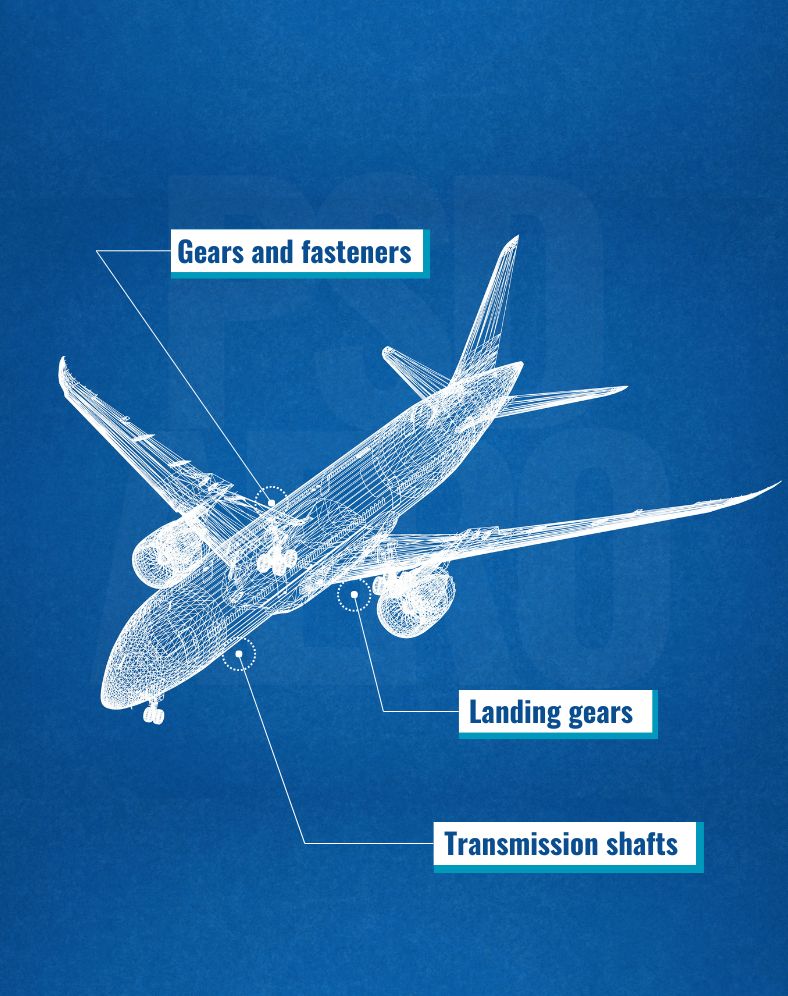
Landing gears
Designed to withstand the severe shocks of landings and takeoffs, landing gears require strong fatigue resistance, such as that provided by 300M steel. Long a competitor of 35NCD16, 300M is now preferred for these applications.
Drive shafts
Connecting engines to propellers or rotors, aircraft drive shafts demand exceptional torsion and fatigue resistance. 300M steel meets these criteria, ensuring efficient power transmission to helicopters and turboprop engines.
Gears and high-strength bolts
The high-strength 300M steel is widely used in critical applications. Its exceptional resistance to wear, high loads, and tensile stress makes it suitable for gears and fasteners in aircraft. Resistant to vibrations, temperature cycles, and high pressures, 300M steel ensures the reliability of propulsion systems and structural components.




